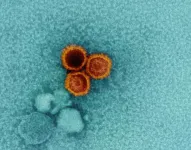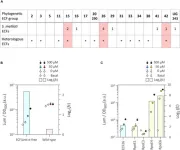(Press-News.org) Researchers at the Department of Energy’s Oak Ridge National Laboratory are taking cleaner transportation to the skies by creating and evaluating new batteries for airborne electric vehicles that take off and land vertically.
These aircraft, commonly called eVTOLs, range from delivery drones to urban air taxis. They are designed to rise into the air like a helicopter and fly using wing-borne lift like an airplane. Compared with helicopters, eVTOLs generally use more rotors spinning at a lower speed, making them both safer and quieter.
The airborne EV’s aren’t just flying cars, and ORNL researchers conclude that eVTOL batteries can’t just be adapted from electric car batteries. So far that has been the dominant approach to the technology, which is mostly in the modeling stage. ORNL researchers took a different tack by evaluating how lithium-ion batteries fare under extremely high power draw.
“The eVTOL program presents a unique opportunity for creating a brand new type of battery with very different requirements and capabilities than what we have seen before," said Ilias Belharouak, an ORNL Corporate Fellow who guides the research.
Researchers are developing new energy-dense materials, learning how these materials degrade under extreme conditions, and developing battery control systems. “This requires us to answer questions about the interplay of battery safety, cycle life and stability at high temperatures, while balancing the need for short bursts of high power with energy reserves for longer-range flight,” Belharouak said.
The first major takeaway from an extensive eVTOL research project underway at ORNL is that the power and performance demands for eVTOL batteries can significantly reduce their longevity and durability.
Unlike electric vehicle batteries, which typically drain at a steady rate, eVTOL batteries need varying amounts of power for flight stages such as climbing, hovering and descent, with some phases requiring high bursts of power.
“Now we know more about what is required of the eVTOL battery, we’ll need to engineer systems differently to achieve that,” said ORNL lead researcher Marm Dixit. “Our focus is fundamental: What happens to the materials under these specific loads and operating conditions? We are trying to figure out the limitations of the battery chemistry we have now, and then tune the battery to bridge that gap.”
The ORNL team made lithium-ion batteries at the DOE Battery Manufacturing Facility located at ORNL and ran them through simulated climb stages of eVTOL aircrafts. Scientists studied what happened inside the battery during cycling – including how much energy was rapidly accessible during the demanding takeoff phase – then tested the battery materials afterward for corrosion and other chemical or structural changes.
Systematic investigation linking actual flight profiles to real-time physical battery operation is rare. However, it is key groundwork for developing new battery chemistries to achieve safe flight performance.
The study incorporates testing of a new ORNL-developed electrolyte — a material through which electrodes exchange ions — against the current state-of-the art version used in lithium-ion batteries. Using the eVTOL mission profiles, the ORNL electrolyte performed better, retaining more capacity during the most power-demanding flight phases.
These results demonstrate the need for diversifying how battery performance is measured, Dixit said. “Your battery is not just capacity at the end of 1,000 cycles. It’s what’s happening within a cycle that tells you whether your system is going to work or crash. And the stakes are much higher here because you’re asking how safe it is to go up in the air. This is a question we don’t know the answer to — yet.”
Members of the research team are working on further improvements to the electrolyte and other battery components as they push the engineering limits for battery power, payload and safety. Recent experiments involved collecting real-world data from drone flights over the lab’s campus, then using that information to develop a customized profile of the load and draw on the battery. Batteries made at ORNL were then run through same cycles.
Funding for the project was provided by the U.S. Army Combat Capabilities Development Command Research Laboratory through the Versatile Tactical Power and Propulsion Essential Research Program. ORNL researchers Anuj Bisht and Ruhul Amin and former ORNL researcher Rachid Essehli contributed to the research, which also utilized the Center for Nanophase Materials Sciences, a DOE Office of Science user facility at ORNL.
UT-Battelle manages ORNL for the Department of Energy’s Office of Science, the single largest supporter of basic research in the physical sciences in the United States. The Office of Science is working to address some of the most pressing challenges of our time. For more information, please visit energy.gov/science.
END
More than flying cars
eVTOL battery analysis reveals unique operating demands
2024-03-12
ELSE PRESS RELEASES FROM THIS DATE:
Centre for Doctoral Training in Diversity in Data Visualization awarded over £9m funding from the EPSRC
2024-03-12
Announced today, a new Centre for Doctoral Training (CDT) has been funded by a grant of over £9 million from the Engineering and Physical Sciences Research Council (EPSRC) to help train the next, diverse generation of research leaders in data visualization.
A collaboration between City, University of London and the University of Warwick, the EPSRC Centre for Doctoral Training in Diversity in Data Visualization (DIVERSE CDT) will train 60 PhD students, in cohorts of 12 students, beginning in October 2025. The set-up phase will begin in July 2024.
The funding announcement is part of a wider UK Research & Innovation (UKRI) announcement of ...
NIH scientists find weak points on Epstein-Barr virus
2024-03-12
WHAT:
Studies of interactions between two lab-generated monoclonal antibodies (mAbs) and an essential Epstein-Barr virus (EBV) protein have uncovered targets that could be exploited in designing treatments and vaccines for this extremely common virus. The research was led by Jeffrey I. Cohen, M.D., and colleagues from the National Institute of Allergy and Infectious Diseases (NIAID), part of the National Institutes of Health. Study findings were published in the journal Immunity.
Approximately 95% of the world’s population is infected with EBV, which remains in the body permanently, typically ...
Spiral wrappers switch nanotubes from conductors to semiconductors and back
2024-03-12
DURHAM, N.C. -- It might look like a roll of chicken wire, but this tiny cylinder of carbon atoms -- too small to see with the naked eye -- could one day be used for making electronic devices ranging from night vision goggles and motion detectors to more efficient solar cells, thanks to techniques developed by researchers at Duke University.
First discovered in the early 1990s, carbon nanotubes are made from single sheets of carbon atoms rolled up like a straw.
Carbon isn’t exactly a newfangled material. All life on Earth is based on carbon. ...
Researchers identify distinct sleep types and their impact on long-term health
2024-03-12
UNIVERSITY PARK, Pa. — Poor sleep habits are strongly associated with long-term chronic health conditions, according to decades of research. To better understand this relationship, a team led by researchers in Penn State’s College of Health and Human Development identified four distinct patterns that characterize how most people sleep. These patterns are also predictive of long-term health, the researchers said.
Soomi Lee, associate professor of human development and family studies at Penn State, ...
City of Hope to present new research at the American Association of Cancer Research (AACR) Annual Meeting 2024, highlighting promising data on prostate, colorectal and pancreatic cancer
2024-03-12
This year, City of Hope doctors and scientists will also present data during AACR’s Press Program and a clinical trials plenary session:
Monday, April 8, 2024, at 8:30 a.m.
Research by Ajay Goel, Ph.D., M.S., City of Hope professor and chair, Department of Molecular Diagnostics and Experimental Therapeutics, and Caiming Xu, Ph.D., a postdoctoral fellow in Goel’s lab, will be presented at an AACR press conference. The abstract is titled “An exosome-based liquid biopsy for non-invasive, early detection of patients with pancreatic ductal adenocarcinoma: A multicenter ...
Exploring the transferability of extracytoplasmic function switches across bacterial species
2024-03-12
Extracytoplasmic function sigma factors (ECFs) have been successfully used for constructing predictable artificial gene circuits bacteria like Escherichia coli, but their transferability between species within the same phylum remained unknown. Now, a recent study by a group of researchers from Germany and Australia explored the bacteria Sinorhizobium meliloti and identified ECF switches with cross-species functionality, constructed genetic circuits, and provided a toolbox for universal synthetic biology applications.
In the field of synthetic biology, creating artificial gene circuits with predictable outcomes is both a challenge and a necessity. Extracytoplasmic function sigma factors ...
Cannabis use and its multifaceted impact on the genitourinary system: a scoping review of the literature
2024-03-12
Background and objectives
Cannabis is a commonly used recreational and therapeutic substance in our society. There are a variety of established physical, social, and mental health impacts associated with cannabis use. However, there is no overview of the impact cannabis use has on the genitourinary system. Thus, this scoping review aims to present data on the impact of cannabis on the genitourinary system.
Methods
A scoping review search was undertaken on Embase, Medline, and Web of Science. There were no date restrictions ...
SwRI develops off-road autonomous driving tools focused on camera vision
2024-03-12
SAN ANTONIO — March 12, 2024 — Southwest Research Institute has developed off-road autonomous driving tools with a focus on stealth for the military and agility for space and agriculture clients. The vision-based system pairs stereo cameras with novel algorithms, eliminating the need for lidar and active sensors.
“We reflected on the toughest machine vision challenges and then focused on achieving dense, robust modeling for off-road navigation,” said Abe Garza, a research engineer in SwRI’s Intelligent Systems Division.
Through internal research, SwRI engineers developed a suite of tools known as the Vision for Off-road Autonomy (VORA). The passive ...
Patients with obesity and kidney failure may be newly eligible for kidney transplants
2024-03-12
Key Takeaways
A collaborative study between bariatric and transplant teams has created a viable pathway for patients with obesity who also have end-stage renal disease to become eligible for kidney transplants through weight loss surgery.
Postoperative outcomes indicate significant improvements in BMI, hypertension, and diabetes management, enhancing patients’ overall health and transplant viability.
High drop-off rates emphasize the need for enhanced patient ...
Ultrablack coating could make next-gen telescopes even better
2024-03-12
WASHINGTON, March 12, 2024 – Sometimes, seeing clearly requires complete black. For astronomy and precision optics, coating devices in black paint can cut down on stray light, enhancing images and boosting performance. For the most advanced telescopes and optical systems, every little bit matters, so their manufacturers seek out the blackest blacks to coat them.
In the Journal of Vacuum Science & Technology A, by AIP Publishing, researchers from the University of Shanghai for Science and Technology and the Chinese Academy of Sciences developed an ultrablack thin-film coating for aerospace-grade magnesium alloys. Their coating absorbs 99.3% of light while being ...
LAST 30 PRESS RELEASES:
University of Oklahoma researcher awarded funding to pursue AI-powered material design
Exploring how the visual system recovers following injury
Support for parents with infants at pediatric check-ups leads to better reading and math skills in elementary school
Kids’ behavioral health is a growing share of family health costs
Day & night: Cancer disrupts the brain’s natural rhythm
COVID-19 vaccination significantly reduces risk to pregnant women and baby
The role of vaccination in maternal and perinatal outcomes associated with COVID-19 in pregnancy
Mayo Clinic smartwatch system helps parents shorten and defuse children's severe tantrums early
Behavioral health spending spikes to 40% of all children’s health expenditures, nearly doubling in a decade
Digital cognitive behavioral treatment for generalized anxiety disorder
Expenditures for pediatric behavioral health care over time and estimated family financial burden
Air conditioning in nursing homes and mortality during extreme heat
The Alps to lose a record number of glaciers in the next decade
What makes a good proton conductor?
New science reporting guide published for journalists in Bulgaria
New international study reveals major survival gaps among children with cancer
New science reporting guide published for journalists in Turkey
Scientists develop a smarter mRNA therapy that knows which cells to target
Neuroanatomy-informed brain–machine hybrid intelligence for robust acoustic target detection
Eight SwRI hydrogen projects funded by ENERGYWERX
The Lundquist Institute and its start-up company Vitalex Biosciences Announces Strategic Advancement of Second-Generation fungal Vaccine VXV-01 through Phase 1 Trials under $40 Million Competitive Con
Fine particles in pollution are associated with early signs of autoimmune disease
Review article | Towards a Global Ground-Based Earth Observatory (GGBEO): Leveraging existing systems and networks
Penn and UMich create world’s smallest programmable, autonomous robots
Cleveland researchers launch first major study to address ‘hidden performance killer’ in athletes
To connect across politics, try saying what you oppose
Modulating key interaction prevents virus from entering cells
Project explores barriers to NHS career progression facing international medical graduates
Jeonbuk National University researchers explore the impact of different seasonings on the flavor perception of Doenjang soup
Two Keck Medicine of USC Hospitals named Leapfrog Top Teaching Hospitals
[Press-News.org] More than flying carseVTOL battery analysis reveals unique operating demands






